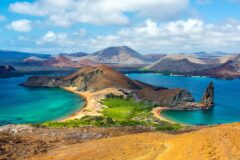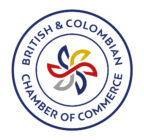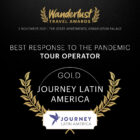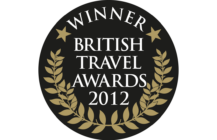
Overview & Highlights
This adventurous Andean group journey traverses South America’s wilderness landscapes from Argentina through Chile and Bolivia to Peru. Explore the Atacama Desert, travel across the Uyuni salt flats and on to Lake Titicaca, Cusco and Machu Picchu.
- Buenos Aires: guided city tour
- Salta countryside excursion
- San Pedro de Atacama: Moon Valley
- Uyuni Salt Flats: Laguna Colorada and other excursions
- La Paz: city tour
- Uros Islands on Lake Titicaca
- Cusco: guided city tour with Sacsayhuamán
- Sacred Valley of the Incas
- Guided tour of Machu Picchu
- Lima: walking tour
A true wilderness adventure, this journey explores one of the world’s most dramatic and ethereally beautiful mountain ranges: the Andes. Setting off from cosmopolitan Buenos Aires, you head northwest to the cultured colonial city of Salta below the foothills of the Andes. Ascend a lonely, precipitous and sinuous cactus-dotted road which crosses the icy range into Chile. Traverse the Atacama desert, the driest on earth, past snow-capped volcanoes and across shimmering salt flats into Bolivia.
Skirting the sapphire waters of Lake Titicaca, you cross the chilly plains of the altiplano before descending into the fertile valleys surrounding the ancient Inca capital of Cusco, visiting traditional adobe villages and open air markets. The climax to this epic journey is the sight of the spectacular Inca ruins of Machu Picchu, crouching on an Andean mountain saddle.
Outline itinerary
UK clients depart arriving in Buenos Aires, Argentina, the following morning.
Day 1
City tour of Buenos Aires
Day 2
Day at leisure in the city.
Day 3
Fly to Salta.
Day 4
Excursion to nearby canyons and vineyards.
Day 5
Cross the Andes into Chile and the Atacama Desert.
Day 6
Excursion to the Moon Valley.
Day 7
Cross into Bolivia
Day 8
Reach the Salar de Uyuni
Day 9
Exploration of the salt flats
Day 10
Guided city tour of La Paz
Day 11
Optional excursions around the capital.
Day 12
Drive to Lake Titicaca.
Day 13
Boat trip to the Uros floating reed Islands.
Day 14
Travel to Cusco by bus.
Day 15
Cusco city tour with Sacsayhuaman.
Day 16
Guided excursion to the Sacred Valley; overnight there.
Day 17
Train to the Lost City of Machu Picchu. Guided tour of the ruins.
Day 18
Optional re-entry to the ruins. Return to Cusco by train.
Day 19
Fly to Lima; guided walking tour of the capital.
Day 20
Depart for your international flight or extension.
UK clients arrive home the following day.
Itinerary
UK clients depart arriving in Buenos Aires, Argentina, the following morning.
Day 1
City tour of Buenos Aires
Those passengers arriving on an international flight will be met at the airport by the tour leader or a local representative and escorted to the group hotel.
In the afternoon a guided tour of the city takes you to the most famous spots the city has to offer. Starting in the centre of the city, the historic heartland, where government buildings and churches mingle with chic shopping districts, which have a nostalgic, Parisian feel. The quintessential district La Boca with its cobbled streets and brightly painted houses is a must, as is the bohemian district of San Telmo, full of quaint old houses interspersed with antique shops, tango bars and expensive restaurants. Slightly further out of town is the Recoleta district, even more evocative of belle époque French and Italianate architecture. The area is home to the cemetery where Evita is laid to rest, and huge tombs line the alleys.
Day 2
Day at leisure in the city.
On your free day you can explore more of what this fascinating city has to offer. Alternatively take a break from the city’s frenzy and travel by boat across the River Plate border to Colonia in Uruguay (don’t forget your passport) where you can wander cobbled streets and admire the squat colonial houses from the top of the lighthouse, and have a glass of wine or lunch in the yacht club.
If you want to visit one of the city’s iconic Tango shows speak to your tour leader who can arrange one for you for the evening.

Day 3
Fly to Salta.
A 2 hour flight takes you to Salta, in north-west Argentina. This charming town lies in the foothills of the Andes, and is surrounded by forested mountains. The colonial centre is a treasure trove of baroque architecture, and the palm-lined main plaza is a lovely place to relax. There are plenty of bars and cafés serving the excellent food for which the region is renowned.
On the outskirts of the town is Cerro San Bernardo, a hilltop that can be reached via a long, arduous stairway, or by cable car, and from which there are sweeping views of the city and the mountains beyond. The anthropological museum here has some wonderfully-preserved Inca mummies which were recently discovered at the peak of a remote mountain, over 6,000m high.

Day 4
Excursion to nearby canyons and vineyards.
From Salta there is a full-day trip to the sleepy town of Cafayate, set among the region’s well respected vineyards. The road follows an arid, winding canyon; its rocky walls ranging in colour from ochre, to yellow, to gold, and spectacular blood-red. There are several stops en route where you can walk up narrow desert valleys and marvel at the views.
The town itself is picturesque, squatting below an Andean backdrop, and there is time to explore as well as to visit one or two of the many local wineries, where there are guided tours and opportunities to sample the wines. One of which, Torrontés, which is unique to Argentina.

Day 5
Cross the Andes into Chile and the Atacama Desert.
There is an early start for today’s long and spectacular journey up through the Andes and into Chile. Upon leaving Salta the bus passes through dense vegetation, palms and bromeliads, before ascending into a mountainous valley with a kaleidoscope of coloured rock faces. A series of hairpin bends then take you into the clouds, and the foliage peters out and is replaced by an arid landscape of cacti and brush.
Soon the parched salt flats of the Salar Grande reveal themselves as you near the international border, a remote outpost at 4,900m, and from here you descend into Chile, passing multi-coloured lagoons which reflect the perfect conical peaks of volcanoes dusted with snow. As you swoop down into the Atacama desert you see a distant patch of vivid green, the oasis of San Pedro, your base for the coming nights. This is a 10hr journey, including stops.
San Pedro is an adobe town somewhat lost in time, with a laid back atmosphere. Its dusty streets are lined with bars, cafés and tour operator offices offering various kinds of excursions into the surrounding desert.
Day 6
Excursion to the Moon Valley.
Should you choose to take this morning’s optional excursion to El Tatio geysers, be prepared for a very early start. But it’s well worth it. You arrive on the pitted, craggy geyser field just before dawn, and as the sun rises and warms the earth, hot steam projects dramatically out of the crater into the freezing morning air, creating a wall of mist through which you can see dark silhouettes and the penetrating sunlight.
On the guided excursion to the Moon Valley you arrive late afternoon to explore shady gorges and dramatic canyons formed over centuries by the erosion of salt mountains. Just before dusk climb to the ridge of a vast golden sand dune to see the landscape lit up in different shades of pinks, reds and oranges cast by the setting sun.

Day 7
Cross into Bolivia
Leaving Chile behind, you embark on an amazing 3 day trip through one of South America’s most unforgettable wilderness landscapes. Travelling to Bolivia by 4WD vehicle, you cross a remote and lofty frost-bitten plateau. The hardships are worth it; this is visually one of the most extraordinary drives in the world; the cold beauty of the ashen hills and strange rock formations is frequently and suddenly broken by the opalescent colours of the remote Lagunas Verde and Colorada. Spend the first night at a desert hotel.

Day 8
Reach the Salar de Uyuni
Today you reach the Salar de Uyuni, a dizzying sight. After exploring the Siloli Desert further, passing more dazzling rock formations and remote lagoons. As the you approach the salt flats the surface becomes utterly featureless, smooth, and composed of nothing but pure, dazzling white salt. After rain a thin layer of water covers the surface, turning the salt flat into a huge mirror that reflects an inverted sky. Spend the night at a salt hotel from where you can enjoy a magical sunset over the white landscape.

Day 9
Exploration of the salt flats
You will spend the whole day exploring the Salt Flats. In the centre lies the Isla del Pescado, a small island covered in giant cacti, where you stop to stretch your legs and soak up the view from the top. At certain times of year flamingos add a vivid splash of pink to the interminable whiteness of the landscape. You will also visit a cave containing pre-Incan mummies and discover how salt is still vital to the local communities at a salt processing plant.
In the evening you arrive in the town Uyuni for the night where you’ll visit the fascinating ‘train cemetery’, a collection of huge rusting steam trains sat peacefully on the edge of town before getting to your hotel for the night.

Day 10
Guided city tour of La Paz
After a short flight you’ll arrive into La Paz. At over 3,500m it’s the highest capital city in the world. It’s a glittering mosaic of tin, slate and tile roofs, interspersed with a line of skyscrapers that march down the valley. And beyond, keeping an eye on it all, is the colossal bulk of Mount Illimani. This busy city has a population which is 60% indigenous. Women dress in voluminous multi coloured skirts and bowler hats and have centre partings, as decreed by the Spanish monarch 3 centuries ago. Your time in the city gives you plenty of opportunity to explore the colonial centre around Plaza Murillo, to stroll through the steep narrow streets, and around the many open and covered markets; it’s the street life here, with its exotic sounds and scents, that make it so fascinating. You are orientated in the compact city centre on a city tour and fly over the city in the network of cable cars that transports the locals around.

Day 11
Optional excursions around the capital.
At leisure further to explore. There is an optional excursion to the ruins of Tiwanaku, about which little is known. Travel 2 hours from La Paz across the bleak, tawny earth of the altiplano, past glimmering lakes and herds of haughty alpacas. These pre-Columbian ruins are considered among the most important on the continent, and the massive gateways and imposing walls are redolent of bygone glory. It is believed that the inhabitants here were more advanced than the Incas in pottery, mathematics, art and astronomy. Explore the museum at the site which houses more than 100 artefacts and provides a fascinating insight into the history of the ruins.
Day 12
Drive to Lake Titicaca.
From La Paz take a scenic road trip to Lake Titicaca. The deep sapphire-hued lake sits high in the Andes on the Peruvian – Bolivian border and is focal point for subsistence farmers in the region who fish its icy waters and plant crops along its shores.
Arrive in Copacabana. This pretty little town is a religious sanctuary (it gave Rio’s famous beach its name), and its whitewashed buildings and Moorish-style basilica are striking against a clear blue Andean sky. The Basilica is frequented by pilgrims to the miraculous 16th-century Dark Virgin of the Lake, and they bring their rickety cars to the forecourt, bedecked in flowers, to be blessed by her.
If you have the energy in this rarefied air, climb the stations of the cross for views out over the lake and the snow-capped cordillera in the distance. From Copacabana there’s an optional boat trip to Isla del Sol. Legend has it that this mystical spot marked the beginning of Inca civilisation. The children of the sun god sprung from the lake’s depths to found the mighty empire in Cusco, and a rock at the northern end of the island was their birthplace. Overnight in a hotel with views out over the lake.

Day 13
Boat trip to the Uros floating reed Islands.
In the morning it’s time to set off to cross the border into Peru, and on to the port of Puno. In the afternoon set out on the lake aboard a motor boat to the Uros Islands; gliding over these deep blue glacial waters is a highlight. You alight on a floating island, made entirely of tortora reeds – the same material the islanders use to build their canoes – and the ground moves almost imperceptibly beneath your feet. A unique feature of this part of the lake is the traditional settlement of Uros people; nowadays, the inhabitants earn their living mainly through selling handicrafts to tourists and, while this is a unique experience, it has the air of a visit to a living museum.

Day 14
Travel to Cusco by bus.
A scenic day-long public bus ride takes you from Puno to Cusco. You cross the altiplano, a large, windswept plain, punctuated by occasional market towns, where bowler-hatted indigenous women tend herds of llamas and alpacas. As the mountains close in, the bus climbs to its highest pass at la Raya (4,200m), and from here the scenery changes dramatically as you race down through the fertile fields of corn and potatoes to Cusco. You arrive in the early evening.
The name Cusco derives from the Quechua word for navel, indicating its location at the centre of the Inca Empire; one which reached its peak as England fought the War of the Roses. This is your base for the coming days. Its many impressive, original Inca walls display extraordinary craftsmanship, and the bustling squares are dotted with ornate colonial churches. It’s a vibrant, lively city, where shoeshine boys and postcard sellers jostle for your attention on cobbled streets lined with handicraft shops and cafés. In the evening, the town centre fills with people flocking to the many restaurants, bars and clubs.

Day 15
Cusco city tour with Sacsayhuaman.
A guide gives you a fascinating tour of Cusco, which includes a visit to several nearby Inca remains. You visit Q’oricancha, once the principal Inca Sun Temple, with extraordinarily intricate stonework, and then explore the colossal zigzag walls of Sacsayhuamán, brooding on a hillside above Cusco. In 1536 a desperate and defining 3 day battle was fought between the Spaniards and the Incas here: the first conquistadors to see it were awestruck and centuries later it is still an extraordinary and imposing sight.

Day 16
Guided excursion to the Sacred Valley; overnight there.
A full-day adventure visits several of the villages and archaeological sites which pepper the Sacred Valley of the Incas. The Pisac complex, set high above the eponymous village, is composed of steep terraces; their engineering and preservation are unrivalled, and you can clamber among the ancient walls and explore the ruins of temples, residences and storehouses. It takes about an hour and a half to explore the site, after which you stop off in the village below where an arts and crafts market spills across the main square, and stalls laden with tapestries and weavings crafted in the surrounding villages.
Continue along this picturesque, patchwork valley to Ollantaytambo, the snow-capped Andean cordillera forming a stunning backdrop. The Inca fortress towering above the adobe village is well preserved and there are wonderful views down over the gentle sloping hillsides and into the fertile valley. You spend the night in the Sacred Valley.

Day 17
Train to the Lost City of Machu Picchu. Guided tour of the ruins.
A dramatic 2hr train journey from Ollantaytambo delivers you to the ruins of Machu Picchu. As the river Urubamba enters its narrow gorge between thickly-forested granite hills, there is room only for a single rail track, which hugs the right bank and passes through hamlets which are no more than a collection of shacks. The citadel is then reached by minibus up a sinuous road.
In 1911 the American explorer Hiram Bingham discovered the ruins buried beneath tropical cloud forest. It is the city’s location which most captures the imagination, on a ridge spur amid forested peaks and above a roaring river canyon. Following a guided tour of the ruins you spend the night at the spa village of Machu Picchu, a couple of kilometres upstream.
Fancy hiking some of the Inca Trail without interrupting your tour? We can organise for you to walk the mini Inca Trail on this day, but still, have a guided tour of the ruins and stay with the group in the evening. Please ask us for more details.

Day 18
Optional re-entry to the ruins. Return to Cusco by train.
You have the optional opportunity to revisit the ruins, rail schedules permitting. There is also the chance for the more challenging hike to Huayna Picchu, the conical peak which juts out behind the ruins for wonderful views over the site. If you think you’d like to re-visit the site or climb Huayna Picchu please enquire with the office, as spaces are limited and it’s necessary to pre-book
You may prefer to relax and wander the narrow vehicle-free streets of Machu Picchu village, lined with souvenir shops and cafés. You return to Cusco on the afternoon train, arriving in the early evening.
Day 19
Fly to Lima; guided walking tour of the capital.
Fly back down to sea level (2 hrs), completing the journey across this extraordinary continent, arriving in Lima, on the Pacific coast. Lima, the City of Kings, was once the capital of Spanish America, and the vestiges of its glorious past can still be seen in the faded grandeur of the colonial churches and traditional wooden balconies in the city centre. The explosive growth of the last 50 years, so typical of capital cities in the developing world, has transformed Lima into a bustling and chaotic low-rise city of over 10 million people.
Away from the busy centre, there are some superb restaurants as well as archaeological museums filled to the rafters with pre-Columbian treasures. In crowded streets, throngs of traffic race out towards Miraflores, on the coast, a modern middle-class suburb where your hotel is located. There will be a walking tour of the colonial centre with your tour leader.

Day 20
Depart for your international flight or extension.
Depending on the time of your flight, there may be time to visit some of the city’s excellent museums. Depart for international flight or extension.
UK clients arrive home the following day.
Essentials
Tour info
About Our Group Tours
To find out more about how our group tours including group sizes, solo travellers and why to choose us. Please click here.
Tour Leader
On this tour, you’ll be accompanied from start to finish by one of our exceptional Journey Latin America tour leaders. From the moment you land in Latin America until the day the tour ends they will deal with all the practicalities, expertly adapting to the circumstances and individual needs of the group. Rather than different guides in different cities, your leader will get to know the group and keep you informed and entertained as you go.
Summary Of Nights
20 days, 19 nights: Buenos Aires 2; Salta 2; San Pedro de Atacama 2; Uyuni salt flats 3; La Paz 2; Copacabana 1; Puno 1; Cusco 2; Sacred Valley 1; Machu Picchu 1; Cusco 1; Lima 1.
Accommodation
For our Discovery Journeys we aim to use good quality, value-for-money accommodation, in a mix of larger more modern and smaller family run hotels. All the properties we use are well maintained and rooms will have a private bathroom with hot water.
The focus of these trips is on getting outside, seeing the sights, and experiencing local restaurants and cafes, therefore a few hotels may not have evening dining facilities. If you prefer more luxurious accommodation, please see our range of classic tours.
During the crossing from San Pedro de Atacama to Uyuni accommodation is more basic, in simple lodges with en suite rooms.
Examples of hotels include:
• Buenos Aires: Hotel Kenton Palace
• Salta: Design Suites
• San Pedro de Atacama: Diego de Almagro
• La Paz: Hotel Rosario
• Salar de Uyuni: Simple lodges around the salt flats
• Uyuni: Hotel Rosario Uyuni
• Copacabana: Hotel Rosario del Lago
• Puno: Hotel Intiqa
• Cusco: Hotel Ruinas
• Sacred Valley: Tunupa Lodge
• Machu Picchu: Hatun Inti Classic
• Lima: Hotel El Tambo
On very rare occasions these hotels can change, however please speak to one of our consultants who can provide full details for each departure if you have any doubts. Address and contact details will be sent out with your final documents.
Transport
3 flights, 2 train journeys ( 2 and 3.5 hrs), 6 road journeys (longest 10 hrs including stops). The only journeys using public vehicles are Salta to San Pedro (although this may be done privately) and Puno to Cusco. The rest will be done using private vehicles for the group.
Meals
Breakfast daily, lunch day 9, full board days 7 and 8.
Optional Excursions
On this tour the price includes excursions in all the places you visit as per the itinerary. There will however likely be some free time when you may choose to take part in an optional excursion. These are booked locally through your tour leader once you are in Latin America, however we are more than happy to advise you of what is on offer in advance of your holiday so you can best plan the excursions that suit you.
Travelling Alone
There is no extra cost for single travellers who are willing to share a room. You will be accommodated with a same-sex member of the group who is usually also travelling solo. For single travellers who wish to be sure of having their own room there are a limited number of single rooms available, which carry a surcharge.
Trip Suitability
The pace of this trip is brisk; there are early mornings and long days spent travelling (albeit with frequent stops and fantastic scenery). The San Pedro – Uyuni crossing involves 2.5 full days’ travel across often bumpy terrain. Consult your tour leader to make sure you undertake optional excursions that are best suited to you.
Climate
This trip operates from March through to October to avoid the wet season in the Andes. Temperatures elsewhere will be pleasant but during the San Pedro to Uyuni crossing, temperatures at night can drop well below freezing. A comprehensive overview of the weather in all the regions you are visiting can be found in our Destination pages. Our Travel Experts can answer your questions on climate and further details will be sent with your confirmation documents.
Altitude
Many of the excursions are spent at high altitude, over 3,500m. Symptoms of altitude sickness vary; most common are mild headaches, slight nausea and breathlessness. Most people are unaffected and if you drink plenty of water and allow your body to acclimatise (don’t exert yourself or drink alcohol) in the first couple of days after arrival, you will minimise your chances of suffering any symptoms. Please refer to out Briefing Dossier for further information.
Clothing, Equipment and Luggage
For day-to-day wear you should go prepared to encounter all seasons. Both warm clothing and a sun hat are essential at altitude; a light fleece jacket and a Gore-Tex outer shell makes a good combination. Trousers or shorts made from light, quick-drying synthetic materials also work well. It can get very cold at altitude, particularly after sundown and so warm clothes are essential as is a good waterproof jacket.
Strong, comfortable footwear is also essential and you should bring insect repellent, sun block and sunglasses. You should take swimwear for visits to thermal baths. A torch can also be useful during your time on the salt flats.
Due to luggage restrictions on the train to Machu Picchu, you will leave the bulk of your baggage in the Cusco hotel, which will be waiting for you on your return. You can take up to 5kgs per person on the train. An overnight holdall/rucksack is recommended to separate your luggage for the time spent away.
Please take note that Aerolineas Argentinas (who will operate some of the internal flights) permit a maximum of 15kg hold luggage on most domestic flights. Excess luggage can be paid for locally for a small fee. Please get in touch with the office before departure if you have any doubts.
Money
Please see the Country Info tab on this holiday for our latest currency information and advice about how to take your spending money. Tipping in Latin America is almost always done using cash. It is customary to tip tour leaders, local guides, drivers, boat crews and other service providers such as restaurant staff and porters. Full tipping guidelines are sent with your confirmation documents as is advice on local costs.
Health, Entry Requirements and Insurance
For health information on travelling to Argentina, Chile, Bolivia and Peru including recommended vaccinations, please see https://travelhealthpro.org.uk/
All Latin American countries have specific entry regulations related to Covid 19. Please also check our Travel Hub for further information.
Holders of a full British passport do not require a visa, although passports should be valid for at least 6 months after the trip begins. Other nationalities should enquire with us or check with the consulates.
Travel insurance is essential. Details of our recommended policy can be found on the Travel insurance website.
What's included in the price
- Services of Journey Latin America tour leader
- All land and domestic air transport
- Accommodation as specified
- Meals as specified
- Excursions as specified
Included Excursions
- Buenos Aires: guided city tour
- Salta countryside excursion
- San Pedro de Atacama: Moon Valley
- Uyuni Salt Flats: Laguna Colorada and other excursions
- La Paz: city tour
- Uros Islands on Lake Titicaca
- Cusco: guided city tour with Sacsayhuamán
- Sacred Valley of the Incas
- Guided tour of Machu Picchu
- Lima: walking tour
What's not included in the price
- Tips and gratuities
- Meals other than specified
- Airport taxes, when not included in the ticket
- Optional excursions


































